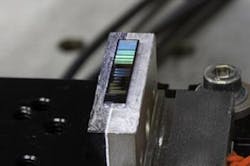Although silicon is a poor emitter of light for classical-light applications such as LEDs and laser diodes, it can be used to generate nonclassical light (light with desirable quantum properties). Researchers from the University of California, San Diego have demonstrated a way to emit and control quantum light—photon pairs—generated using a chip made from silicon.1
The researchers suggest that their CMOS-compatible silicon photon-pair-generation chip could be used as part of a “quantum transceiver” module, which would eventually integrate a controllable photon source with a sensitive photon detector in a single package. This type of device, which is used for secure communications, would be much cheaper and easier to manufacture out of silicon, rather than via the conventional approach of using III-V compound semiconductors.
“Silicon is known to be a poor light-emitting material—there is no silicon diode laser, for example, despite many decades of research,” says Shayan Mookherjea, an associate professor of electrical and computer engineering at UC San Diego. “However, if you want to make a chip that emits quantum light such as pairs of single photons which are entangled in some quantum-mechanical properties and you want to do it at room temperature so that the chip can be widely used, then it turns out that silicon is actually quite a good material for generating photons.”
Generated via four-wave mixing
The photon pairs are generated via the spontaneous four-wave mixing (SFWM) nonlinear Kerr interaction, which produces a "signal" and an "idler" photon, one with a frequency higher than the input and the other lower. THe device itself has coupled microring resonators, operates at around room temperature, and allows easy coupling into an optical fiber.
“By varying the chip temperature by only a few degrees, we can tune the degree of entanglement by more than a factor of three, as measured by a typical metric called the Schmidt number,” says Ranjeet Kumar, an electrical engineering graduate student at UC San Diego and lead author of the paper. “A low Schmidt number represents a device generating photon pairs that has been tuned for a particular quantum-optic property called heralding, whereas a high Schmidt number shows that the device generates photons which can be used to encode more than a single quantum bit of information per photon. Our device can be tuned over a wide range of Schmidt numbers, whereas other photon pair sources generally cannot, or require complicated additional apparatus to do so -- typically thousands of times larger in size than our chip."
Source: http://www.jacobsschool.ucsd.edu/news/news_releases/release.sfe?id=1680
REFERENCE:
1. Ranjeet Kumar et al., Nature Communications (2014); http://dx.doi.org/10.1038/ncomms6489

John Wallace | Senior Technical Editor (1998-2022)
John Wallace was with Laser Focus World for nearly 25 years, retiring in late June 2022. He obtained a bachelor's degree in mechanical engineering and physics at Rutgers University and a master's in optical engineering at the University of Rochester. Before becoming an editor, John worked as an engineer at RCA, Exxon, Eastman Kodak, and GCA Corporation.
